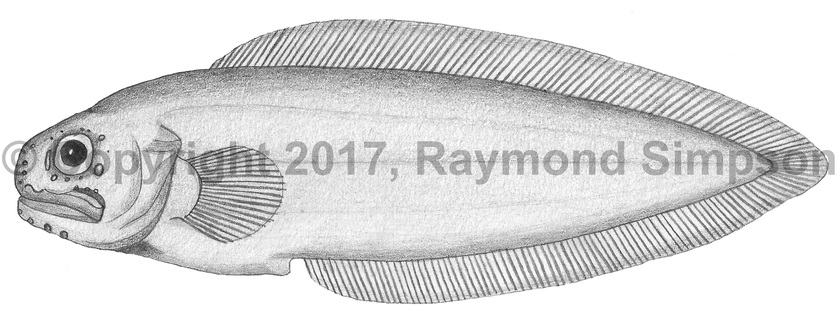
Common Name
Medusa Brotula
Year Described
Cohen, 1963
Identification
Dorsal Fin: 72-79
Anal Fin: 58-65
Pectoral Fin: 22-29
Caudal Fin: 10
Vertebrae: 48-50 total
Body elongate and tapering toward the tail. Fairly slender (depth 23-32% SL). Snout rounded. Eye large (24-29% HL). Nostrils circular and close together. Mouth extends past eye. Teeth in jaws, palatine, and vomer. Pores obvious (1 preopercular, 3 supraorbital, 8 infraorbital, and 4 mandibular). Dorsal fin originates over pectoral fin. Anal fin originates close to mid-body. Fleshy sheaths cover both fins. Pectoral fin rounded but broad. Pelvic fins small with two rays. Tail contiguous with median fins. Two lateral lines covered in sensory papillae. Small scales present on rear of body. Skin very thick.
Color
Fish out of water uniformly dark purplish-brown with darker fins and head. Fish filmed with ROV's are uniformly pale gray in appearance.
Size
Maximum size to 22cm SL.
Habitat
Associated with the midwater jellyfish (Stygiomedusa spp.) where it lives on and around the body of the jellyfish. Taken in open water between 500-1000m.
Range
Known currently from the western Atlantic off New England and in the Gulf of Mexico. Likely widespread in the North Atlantic and the southern Ocean where their host medusa is found.
References
Benfield, M.C., & W.M. Graham. 2010. In situ observations of Stygiomedusa gigantea in the Gulf of Mexico with a review of its global distribution and habitat. Journal of the Marine Biological Association of the United Kingdom, 90(6), 1079-1093.
Lee, R.S. 1974. Thalassobathia nelsoni, a new species of bathypelagic ophidioid fish from Chilean waters. Copeia, 629-632.
Prokofiev, A. M., & E.I. Kukuev. 2008. Comparative characteristics of North Pacific and North Atlantic specimens of a rare bathypelagic fish Thalassobathia pelagica (Teleostei: Bythitidae) with discussion of its distribution. Journal of Ichthyology, 48(8), 565-572.
Other Notes
Unique among ophidiiformes in it’s association with large pelagic medusa. Likely found worldwide but poorly sampled.